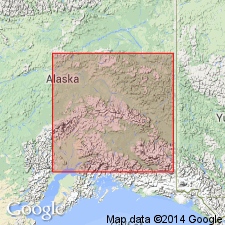
- Usage in publication:
-
- Goldstream Formation*
- Modifications:
-
- Named
- Geochronologic dating
- Dominant lithology:
-
- Loess
- AAPG geologic province:
-
- Alaska East-Central region
Summary:
Unit is named the Goldstream Formation. Deposit long informally known as Goldstream muck. Consists of perennially frozen retransported bedded, loess that is black to greenish-black in color. A thin white vitric volcanic ash layer, Chatanika Ash Bed is [enclosed] within the formation. Thickness is 15 m at type and ranges 10 to 35 m. Gradationally overlies Eva Formation, and unconformably overlies Fox Gravel, Tanana Formation, Gold Hill Loess, Dawson Cut Formation, and Cripple Gravel. Unconformably underlies Ready Bullion Formation and Engineer Loess. Is greatest repository of remains of Pleistocene vertebrates in Alaska. Most abundant remains are bison, with mammoths and horse next in abundance. More than 60 radiocarbon ages record material older than 10,000 yr B.P., and many ages are older than 30,000 yr B.P. Age is Pleistocene (Wisconsinan).
Source: GNU records (USGS DDS-6; Menlo GNULEX).
For more information, please contact Nancy Stamm, Geologic Names Committee Secretary.
Asterisk (*) indicates published by U.S. Geological Survey authors.
"No current usage" (†) implies that a name has been abandoned or has fallen into disuse. Former usage and, if known, replacement name given in parentheses ( ).
Slash (/) indicates name conflicts with nomenclatural guidelines (CSN, 1933; ACSN, 1961, 1970; NACSN, 1983, 2005, 2021). May be explained within brackets ([ ]).

